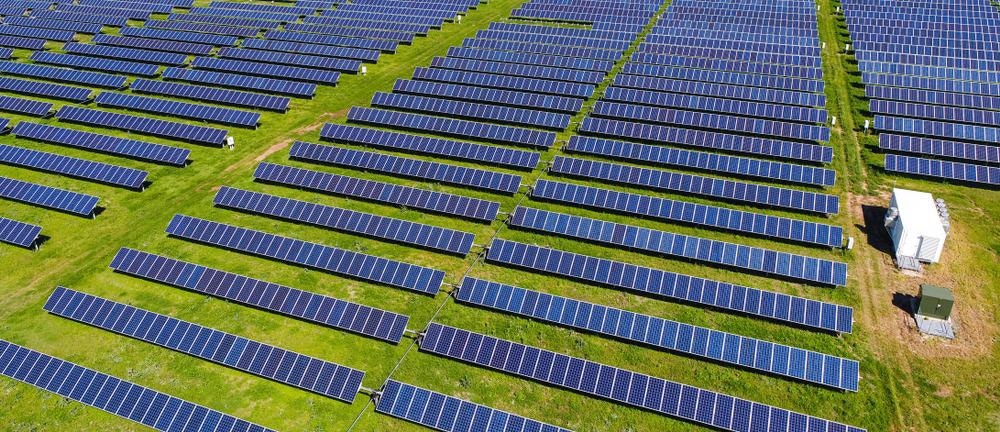
Image Credit: Roschetzky Photography/Shutterstock.com
A key challenge in developing large-scale solar photovoltaic (PV) systems is finding the right location: close to existing power structures, abundant in space, secure, and, ideally, a site that can offer a good economic incentive to invest.
Airports meet many of these requirements, and new research suggests they are being underutilized in the pursuit of a zero-emission economy. Research, published in The Journal of Building Engineering by a team from RMIT University, Australia, argues that fully integrated solar airports would significantly reduce greenhouse gas emissions and could be up to 10 times more effective than existing residential rooftop PV systems.
The Case for Solar Airports
Solar PV systems can be classified as either small-scale or large-scale according to the power they generate. In Australia, for example, solar systems are considered large-scale if they generate over 100 kW and small-scale if they generate 100 kW or less.
Both systems have their own advantages and disadvantages in terms of cost and energy generation and even the most devoted advocates of each approach will concede that both systems have an important role in creating a zero-emission economy.
Airports are considered ideal sites for large-scale (sometimes referred to as utility-scale) solar PV projects. They are typically made up of large, isolated, mostly low-rise structures away from heavy shading and have swathes of underutilized land which could accommodate PV modules. Airport sites are also close to major power lines which minimizes the high upfront costs of connecting to the main grid.
From an economic perspective, energy costs have a substantial impact on an airport’s bottom-line. The average airport uses 19.7 kWh of electricity and 34.7 thousand Btu of natural gas per square foot annually – as much as a small town. These energy costs are approximately 10-15% of an average airport’s operating budget.
If large-scale solar PV can be effective enough to make airports energy self-sufficient, which research suggests it can, there is an attractive win-win for airport executives looking to reduce operating costs while also improving their green credentials by reducing GHG emissions and offsetting carbon.
New Evidence from Australia
Australia is notable for the success it has had in adopting small-scale solar systems such as residential rooftop PV. Over the last five years, renewable energy generation has almost doubled in Australia and now accounts for more than a quarter of Australia’s electricity supply. According to Australia’s renewable energy association, “much of this increase was due to the small-scale solar sector, which added more than 3 GW of new capacity in 2020”.
Although small-scale solar systems in Australia have enjoyed tremendous success, the RMIT researchers say small-scale solar may not be the most ideal system for electricity generation or for reducing CO2 emissions. They also believe the government’s support of small-scale residential solar is undermining potentially more effective large-scale projects – such as solar airports.
The team’s research into the potential of large-scale rooftop PV systems, specifically for the 2.61 km2 of usable rooftop space which they calculated could be utilized across all 21 of Australia’s government-owned airports, suggested it would generate 488.68 GWh – enough for 136,000 homes. This is 10 times more than the power generated by all 17,000 residential solar rooftop PV panels installed in one of Australia’s largest inland cities, Bendigo.
The airport solar panels would also offset 151.6 kt of GHG emissions annually and generate enough electricity to send excess back to the grid.
Growing Interest in Solar Airports
As costs for solar PV systems continue to fall worldwide, the commercial and environmental case for solar airports will strengthen even further.
In 2015, at least 100 airports worldwide had invested in solar energy and generating approximately 400 MW of power per year in total. This includes London Heathrow, Denver International, Kuala Lumpur International, Hyderabad and Adelaide airports.
New projects have been announced too. Notably, Edmonton International Airport (EIA) in Canada announced it will begin building the world’s largest airport-based solar farm in 2022. According to EIA, the 627-acre farm will produce enough electricity to power between 27,000 and 28,000 homes (120 MW) and will offset approximately 106,000 tons of CO2 per year.
References and Further Reading
Athenee Teofilo, Qian (Chayn) Sun, Nenad Radosevic, Yaguang Tao, Jerome Iringan, Chengyang Liu (2021) Investigating potential rooftop solar energy generated by Leased Federal Airports in Australia: Framework and implications. Journal of Building Engineering. https://doi.org/10.1016/j.jobe.2021.102390
Small-scale Solar Becomes Second Biggest Player in Australia’s Renewable Energy Mix as CEC reveals slate of overhauled records [Online] (2021) PV Magazine. Available at: https://www.pv-magazine-australia.com/2021/03/30/small-scale-solar-becomes-second-biggest-player-in-australias-renewable-energy-mix-as-cec-reveals-slate-of-overhauled-records/ (Accessed on 27 May 2021).
Airports [Online] DTE Energy. Available at: https://dteenergy.bizenergyadvisor.com/article/airports (Accessed on 27 May 2021).
Utility-scale Solar [Online] DNV. Available at: https://www.dnv.com/feature/utility-scale-solar.html (Accessed on 27 May 2021).
World’s-largest airport solar farm arriving at EIA [Online] FlyEIA. Available at: https://flyeia.com/corporate/media/news/worlds-largest-airport-solar-farm-arriving-at-eia/ (Accessed on 27 May 2021).
Disclaimer: The views expressed here are those of the author expressed in their private capacity and do not necessarily represent the views of AZoM.com Limited T/A AZoNetwork the owner and operator of this website. This disclaimer forms part of the Terms and conditions of use of this website.